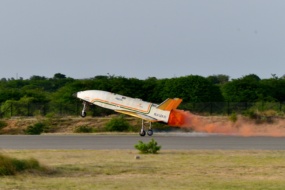The JUICE is Jupiter-bound.
ESA’s Jupiter Icy Moons Explorer (JUICE) spacecraft launched aboard an Ariane-5 rocket this morning from the European Spaceport in French Guiana. The probe will perform four gravitational assist fly-bys of Venus and Earth before heading to Jupiter, where it’s scheduled to arrive in July 2031.
The squeeze: JUICE will spend three to four years in the Jovian system, primarily exploring Jupiter’s Europa, Ganymede, and Callisto moons.
The three moons are believed to contain large bodies of liquid water underneath their icy surfaces. Scientists are eager to determine whether these oceans could host conditions conducive to forming life.
The primary objectives of the mission are:
- Search for biosignatures and signs of habitable conditions
- Map the geology, magnetic fields, and atmosphere of the moons
- Analyze Jupiter’s dynamic environment, specifically its magnetosphere
Weighing 2,400 kg, the spacecraft is equipped with 10 advanced scientific instruments to assist with its analysis. The instruments include remote sensors, geophysical detectors, and in-situ tools.
A closer look: The probe will spend months orbiting Jupiter and complete multiple fly-bys of the three moons before inserting into Ganymede’s orbit for a closer look. Ganymede is the largest moon in our solar system and the only one with a magnetic field. It’s believed to harbor oceans ten times deeper than Earth’s.
Last drop: When the spacecraft finally runs out of juice in 2035, it will say its final goodbye before impacting into Ganymede. ESA estimates the total cost of the mission to be €1.6B ($1.8B).
NASA’s trip to Jupiter: In 2024, NASA will launch its own probe to Jupiter, the Europa Clipper. The spacecraft is expected to arrive in the Jovian system in 2030, a year ahead of JUICE, and will focus its studies on Europa.




